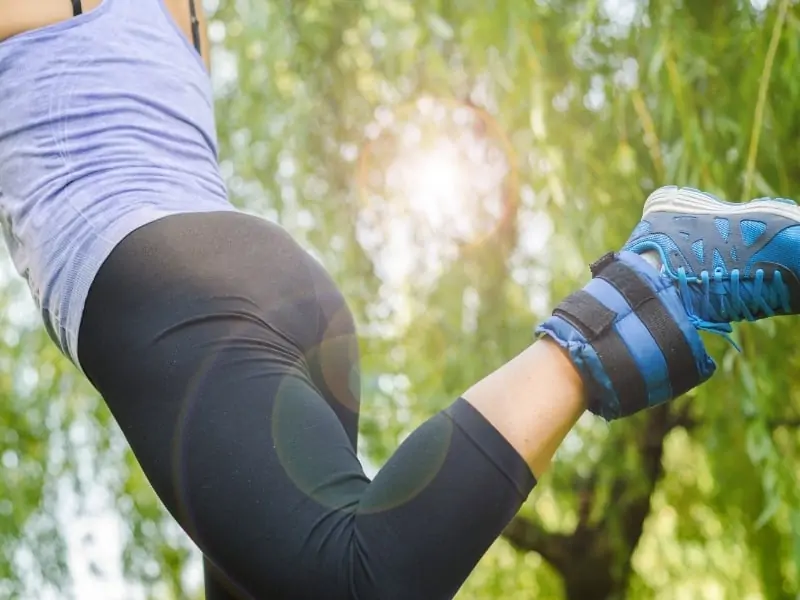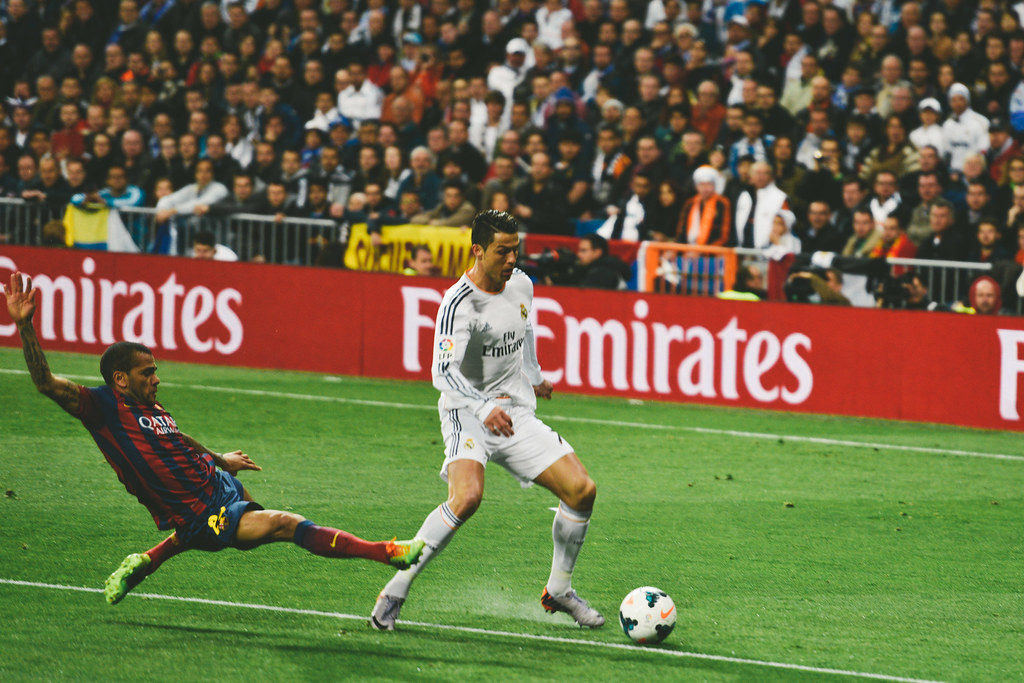Share the post "Ankle Weights For Soccer (Benefits + Training Drills)"
Ankle weights have long been a topic of debate in sports. They are essentially miniature bags filled with sand, steel shot, iron powder, or water that can be strapped to your ankles to improve balance and increase fitness as part of an overall exercise routine.
As a tool that’s been praised and criticized in the past, are ankle weights good for soccer players?
Some of the key areas we will touch on include:
- The arguments for and against ankle weights
- If ankle weights can help soccer players
- Ankle weight exercises for soccer players
This article explores the research surrounding ankle weights and weighs up the pros and cons of whether or not they are worthwhile for players.

The Arguments For and Against Ankle Weight Training
While ankle weights have not been studied as extensively as other training equipment, research has shown some positive results from incorporating them as part of a training routine.
However, the improvements aren’t necessarily advantageous for professional-level athletes.
Here’s what we found out.
How Ankle Weights Help
The theory behind the use of ankle weights is quite straightforward.
With an additional weight around the legs, wearers must expel more force to move them.
For example, if you run a mile with ankle weights on, you will use more energy than running a mile without them. Likewise, leg raises or hurdles in soccer training would be more taxing with 3 lb weights strapped to each ankle.
Performing certain exercises with ankle weights can aid muscle development, particularly in the legs.
Your quadriceps, hamstrings, calves, and glutes can all benefit from resistance training with ankle weights. This type of training may also improve cardiovascular fitness and strengthen the tendons around the joints.
“The added weight makes the muscles work harder. Muscles that work harder get stronger through muscle fiber growth, more efficient muscle fiber recruitment, or more blood vessel growth to or within the muscle to deliver more oxygen to the working cells.”
Eric A. Eifler, M.D., CAQSM, an orthopedic surgeon at Phoenix Spine & Joint.
Intelligent training with ankle weights can bring about positive results that may contribute to improvements in the field.
However, it’s also important to consider the potential risks of ankle weight exercise.

Risks Associated with Ankle Weights
Overusing ankle weights can have negative impacts on performance. Extra weight puts increased strain on the joints and ligaments which may lead to injury.
As soccer is such a dynamic sport, it is extremely important to keep knee and ankle tendons as healthy as possible.
Never use heavy ankle weights! Both straps combined should weigh between 1% and 2% of your total body weight.
Although some people benefit from running with ankle weights, it comes with significant risks. As running is a rhythmic exercise with a repetitive pattern, an altered technique often leads to muscle imbalances.
Imbalances and extra weight on the joints, back, hips, knees, and ankles can disrupt a runner’s gait over time, which can cause severe injuries, such as ACL tears.
For professional athletes, perhaps the juice is not worth the squeeze when it comes to training with ankle weights.
In an interview with Runner’s World, Katie Lawton, ME.d., an exercise physiologist in Sports Medicine at Cleveland Clinic, suggests that cross-training and strength and conditioning have proved to be successful and might be a better approach for achieving your desired athletic results.
Incorporating different types of speed, strength, and conditioning drills into your soccer routine may be more beneficial in the long run.
A mixture of high-intensity drills, endurance runs, and weight training can help you hit your physical goals without the increased risk of injury.

Ankle Weight Exercises For Soccer Players
Retired Manchester United player and former teammate of Cristiano Ronaldo, Quinton Fortune, revealed that CR7 himself used to train with ankle weights when he first burst onto the scene at Manchester United.
While sports science has improved a lot since 2003, who’s to say that ankle weight training didn’t help Cristiano to develop some of the quickest feet in the game?
When quizzed about these claims, Ronaldo responded by clarifying Fortune’s statements and crediting ankle weight training as an important element of his progress as a player.
“I think it worked well, because what I am today started from that moment. I did weights on my feet when jumping and dribbling, then I’d take them off and feel faster.”
Cristiano Ronaldo
Although we can’t recommend performing dribbling, sprinting, and jumping drills with ankle weights on, there are some other resistance-based exercises that can improve your overall game.
Before attempting any of these drills be sure to perform a thorough warmup, including dynamically stretching your leg muscles to avoid injury.
If at any point the exercises don’t feel right, stop. This could indicate that your form is incorrect or your body is not ready for weighted exercises, putting you at risk of getting hurt.
Note: all exercises are to be performed with ankle weights correctly fitted to both legs. If you haven’t already sourced a set of ankle weights, these won’t break the bank.
Superman Extensions
This exercise works your glutes, back, hips, and shoulders, improving your balance and core strength, which are two important qualities for soccer players.
- Lie with your belly to the floor. Extend your arms directly in front of you, and keep your legs flat to the ground behind you.
- In a single movement, raise your arms, legs, and chest off the floor while engaging your lower back and glutes. Hold this position for 1 second then return to your original position.
- Perform 3 sets of 10 reps.
Squats and Lateral Leg Lifts
This is a real thigh burner that can work wonders for all of your major leg muscles as well as your abs.
- Stand upright with your legs a little more than shoulder-width apart.
- Keeping your back straight, bend your legs, and drop into a squad. Your legs should form at least a 90-degree angle with the ground. Keep your knees behind your toes.
- Drive upward by pushing through the heels to regain your upright position.
- As you ascend, lift your right leg up and outward until it is fully straightened and flexed. Then bring it back down until you’re in your original standing position with your feet just over shoulder-width apart.
- Repeat the steps but lift your left leg this time.
- Perform 3 sets of 10 reps (5 on each leg). If you want more of a challenge, consider upping this to 5 sets or increase the number of reps.
Step-Ups
For this exercise, you’ll need access to a step or a plyometric box, which you can find here. Step-ups help develop the hamstrings, quadriceps, and glutes, giving you improved power and explosivity.
- Step with one foot onto the plyo box with your knee over the ankle.
- Keeping your back as straight as possible, propel your body upward using the stepping leg. Engage the glutes and drive through your heel.
- Stand upright on one foot before returning to your original position. At this point, you’ve completed a single rep.
- When you’re finished with your reps on the lead leg, repeat the motion using the opposite leg.
- Perform 3 sets of 20 reps (10 on each leg).
Single-Leg Knee to Elbow
This exercise helps loosen the hips and works on your obliques, an important muscle for tackling and changing direction.
- Stand with your legs shoulder-width apart.
- Shift your weight to your right leg and extend your right arm upward above your head.
- Bring your right elbow back down toward your hips, and at the same time, raise your left knee to hip level until it meets your elbow.
- When you’ve finished your reps on one side, switch to the other.
- Perform 3 sets of 20 reps (10 on each side). Feel free to increase the number of sets and reps.
Side-Lying Leg Lifts (Hip Abduction)
This exercise is great for core strength and also works the glutes and hip flexors. It can be used as a strengthening exercise and to help prevent injury.
- Lie on your side with your hips stacked and your legs together. Use your upper arm and elbow for balance and to support your head.
- Keeping both legs straight, raise your top leg slowly. It may take a few tries to find a comfortable height. After several training sessions, your dexterity will improve.
- Engage the glutes and pause for a second at the top of the movement before slowly lowering your leg to its original position.
- Once you’ve finished your reps on one leg, switch to the other side.
- Aim for 3 sets of 20 reps (10 on each side). This exercise may be harder than it sounds so only do what you’re comfortable with.
Share the post "Ankle Weights For Soccer (Benefits + Training Drills)"
Joel is a seasoned soccer journalist and analyst with many years of experience in the field. Joel specializes in game analysis, player profiles, transfer news, and has a keen eye for the tactical nuances of the game. He played at various levels in the game and coached teams - he is happy to share his insight with you.



